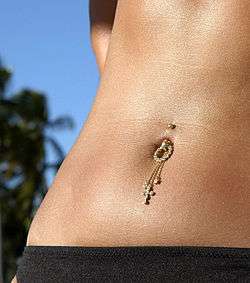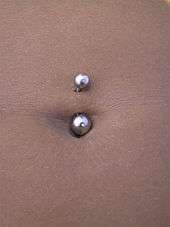Navel piercing
| Navel piercing | |
|---|---|
 | |
| Nicknames | Belly-button piercing |
| Location | Navel |
| Jewelry | Barbell, captive bead ring |
| Healing | 6-9 months |
A navel piercing (also referred to as a belly button piercing or an umbilical dip piercing) is a type of piercing located in, or around, the navel. It may heal quickly and with no problems, like an ear piercing, or may heal more like a surface piercing with the associated extended healing time. Healing usually takes less than six months, and as long as it is cleaned, it will heal nicely.[1] Unlike most surface piercings, this is one of the few that do not normally reject, although the rejection rate is higher than non-surface piercings, such as ear piercing The actual navel is not pierced when a navel piercing is performed. The most common form of navel piercing is through the upper rim of the navel.
History and culture

In ancient times the body piercing was considered as sign of manliness and courage. The Egyptian Pharaohs believed the earring at the navel to be a sign of ritual transition from the life at the Earth to the eternity.[2]
The history of navel piercing has been particularly misrepresented as many of the myths promulgated by Malloy in the pamphlet Body & Genital Piercing in Brieef continue to be reprinted.[3][4] For instance, according to Malloy's colleague Jim Ward, Malloy claimed navel piercing was popular among ancient Egyptian aristocrats and was depicted in Egyptian statuary,[4] a claim that is widely repeated.[5][6] Other sources say that there are no records to support a historical practice for navel piercing.[7]
The navel piercing is one of the most common body piercings today.[8] Popular culture has played a large role in the promotion of this piercing. The navel piercing first hit the mainstream when model Christy Turlington showed her navel piercing at a fashion show in London in 1993. The popularization of the piercing, however, is accredited to the 1993 Aerosmith music video for their song "Cryin'," wherein Alicia Silverstone has her navel pierced by body piercer Paul King.[9] The easy concealment of a navel piercing with clothing, even during the healing process, has contributed to the widespread adoption of this piercing.
Jewelry


Navel jewelry has become more extensive in recent years. Many new designs, such as the ancient Bali jewelry designs, have been added to everyday navel cultures. Barbells remain the most common. The worlds first belly huggy was designed and patented by TummyToys® navel rings. Vogue fashion published an article in 2015 about the circular captive bead belly rings and TummyToys® snap lock clasps becoming the current trend for navel piercings. Most kinds of ring or bar jewelry can be worn in a navel piercing. Navels are most often pierced with a 14g curved barbell, which is recommended to be worn until the piercing has fully healed, the healing time is typically anywhere between 6 - 12 months. A wide variety of decorative jewelry is available for navels - simple curved barbells, captives, TummyToys® belly huggies, flexible PTFE and fancy long length styles with dangling pendants. These days real diamond and solid gold belly rings are also available in a wide range of styles. Most kinds of ring or bar jewelry can be worn in a navel piercing, both for top and bottom piercings.
There has been a special standard established for navel barbells (also called "bananabells" or "bananabars", a reference to their curved shape). The standard barbell is 1.6 mm (1/16") thick and 9.5 mm (3/8") or 11.1 mm (7/16") long and is most commonly referred to as a 14-gauge post. The silver caps on the barbell post usually measure 5mm in diameter for the upper and 8mm in diameter for the lower.
Although navel bananabells are different from full rings, such as captive bead rings (CBRs), which can also be worn in navel piercings, internet body jewelry retailers and wholesalers tend to refer to these barbells as belly button "rings".
A new version of navel jewelry is on the market for those without pierced navels, which is based on the idea of clip-on earrings.
Risks
Although navel piercings are fashion symbols and may make the navel and midriff look more attractive, they carry the many risks of body piercing, notably:
- Infection: A new piercing may take up to 6–9 months before it can be taken out, during which time sweat and bacteria may cause infection. Bacterial infections can result in cysts.
- Scarring: Skin tissue rarely heals to match the surrounding tissue. It heals in varying thickness, in different ways for different types of people, and forms different types of scarring for different kinds of 'damage'. It is likely that any piercing worn for a significant time (months to years) will leave a scar if removed.
- Rejection: Bad care of the navel piercing and/or hitting it strongly can cause the body to reject the navel piercing (the body pushes the piercing out, breaking the skin tissue on top of the piercing). Rejection can also happen for unknown reasons.
- Migration: Migration can happen when there is too much movement for the piercing to heal comfortably around the navel area. The skin will push the barbell out a few millimetres, again, breaking the skin tissue in order to find a more comfortable place to allow the piercing to heal. To avoid migration, make sure to avoid excessive movement with a fresh belly ring.
References
- ↑ "Letters to Health". Pittsburgh Post-Gazette. December 6, 2006. Retrieved November 29, 2014.
- ↑ "THE PIERCING SUBCULTURE – A RISKY OBSESSION OR AN OBSESSIVE RISK". FASHION LIFESTYLE. Retrieved 19 February 2012.
- ↑ Angebring itl, Elayne (2009). The Piercing Bible: The Definitive Guide to Safe Body Piercing. The Crossing Press. ISBN 1580911935.
- 1 2 Ward, Jim (23 January 2004). "Who was Doug Malloy". BMEzine. Retrieved 7 May 2010.
- ↑ Miller, Jean-Chris (2004). The Body Art Book. Penguin. ISBN 0425197263.
- ↑ Vale, V.; Andrea Juno (1989). Modern Primitives: an Investigation of Contemporary Adornment & Ritual. Re/Search Publications. ISBN 9780940642140.
- ↑ "Navel piercing. Unlike the other body piercings, this one has not been recorded in history." (Parents 2007, p. 151)
- ↑ Marc Oxoby. The 1990s American popular culture through history. Greenwood Publishing Group. p. 117. ISBN 0313316155. Retrieved 15 May 2015.
- ↑ Aerosmith - BME Encyclopedia